SECTION A (25 marks)
Answer all the questions in this section in the spaces provided.
- Figure 1 shows a ray of light incident on a plane mirror.

Complete the diagram to show the path of the reflected ray. (1 mark) - Figure 2a, 2b and 2e show the process of charging an electroscope by induction
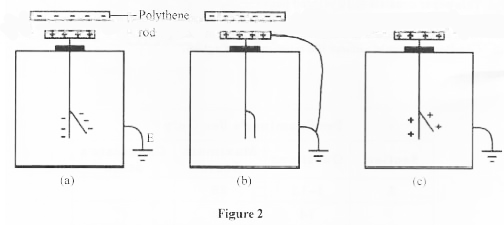
It is observed that the leaf rises in (a), collapses in (b) and then rises in (c). Explain why the leaf collapses in (b). (3 marks) - State one use of capacitors. (1 mark)
- Figure 3 shows a graph of magnetic strength against time for two nails P and Q when magnetised in a solenoid. P and Q are of the same size but are made of different materials.

- Identify the material that is magnetised faster. (1 mark)
- Use the domain theory to explain the answer in 4(a). (2 marks)
- State the meaning of the term principal focus of a convex mirror (1 mark)
- Figure 4 shows a current carrying conductor placed between the poles of two magnets. (The direction of the current is into the paper).

Sketch the magnetic field produced between the conductor and the poles of the magnets. (2 marks) - Figure 5 shows two coherent sources of sound A and B in phase. O is a point equidistant from A and B.
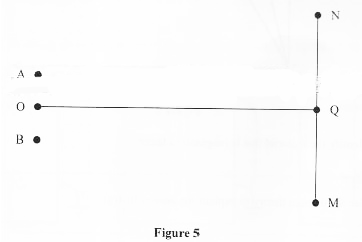
An observer moves from Mto N through Q. Explain what is observed at point Q. (3 marks) - State one factor that affects the speed of sound in water. (1 mark)
- Figure 6 shows a ray of light incident on a prism with a critical angle of 42º

Complete the diagram to show the path of the ray through the prism. (2 marks) - It is observed that when the heat current of the cathode ray tube is increased, the intensity of the cathode rays increase. Explain this observation. (2 marks)
- A current of 2A flows through a bulb for 2.5 minutes. Determine the quantity of charge that flows through the bulb.(3 marks)
- Figure 7 shows UV light passing through an aperture and incident on the cathode of a photocell.

- State what is observed on the milliammetre when the size of the aperture is increased
- State the reason for the answer in 12(a) (1 mark)
- State the property of radio waves that makes them suitable for use in communication. (1 mark)
SECTION B
Answer all the questions in this section in the spaces provided.
-
- State and explain how increase in temperature affects the conductivity of a semiconductor. (2 marks)
- Figure 8 shows a graph of potential difference (V) across a bulb against the current (I) through the bulb obtained from an experiment.
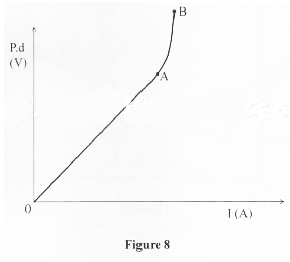
Explain why parts:- OA is straight (1 mark)
- AB is curved. (2 marks)
- A circuit consists of 20 identical lamps connected in series to 240 V mains supply. Determine the potential difference across each of the lamps. (2 marks)
- Figure 9 shows a circuit consisting of two identical lamps and three ammeters A1, A2, and A3, connected to a cell.
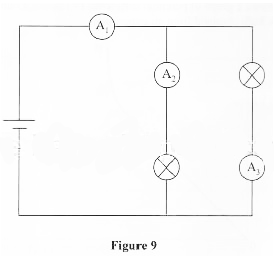
Given that ammeter A, reads 0.5 A:- state the reading on Ammeter A3(1 mark)
- explain the answer 14(d) (i). (2 marks)
-
- State the use of the eye piece lens in a compound microscope. (1 mark)
- On the grid provided, draw a ray diagram to show how a convex lens forms a magnified real image. (3 marks)

- Figure 10 shows a defect of vision in a human eye

- State the type of defect shown. (1 mark)
- State the type of lens that can be used to correct this defect. (1 mark)
- On the same figure, draw rays to show how the lens in 15(c)(ii) corrects the defect. (2 marks)
- Figure 11 shows a graph of image distance (V) against the object distance (U) obtained in an experiment to determine the focal length of a concave mirror.
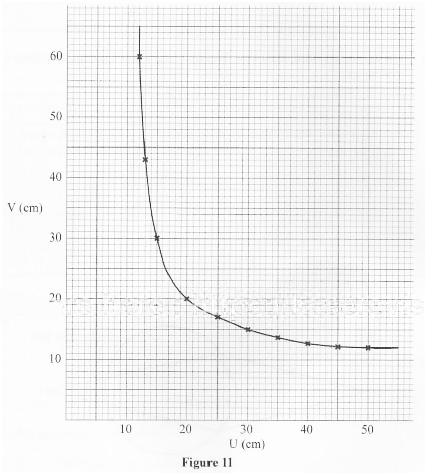
- Identify and mark a point X on the graph where V = U.
- Use the point X to determine:
- the radius of curvature r. (2 marks)
- the focal length of the lens f. (1 mark)
-
- State Faraday's law of electromagnetic induction. (1 mark)
- Figure 12 shows a bar magnet being moved towards a solenoid. The solenoid is connected to a galvanometer.
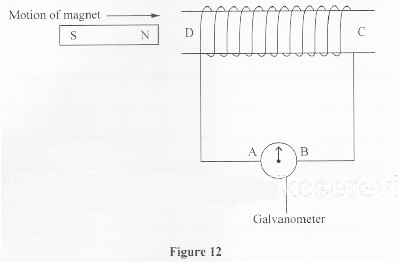
- Indicate on the diagram the direction of the induced current in the solenoid. (1 mark)
- Identify the pole induced at D. (1 mark)
- Explain the answer in 16(b)(ii). (2 marks)
- Apart from the number of tums in the solenoid, state two factors affecting the magnitude of the induced current. (2 marks)
- Explain how laminating the core of a transformer increases its efficiency. (2 marks)
-
- Explain how a fuse protects electrical devices from damage. (2 marks)
- State and explain why the voltage in mains electricity is stepped up before long distance transmission (3 marks)
- Figure 13 shows how power can be transmitted from the generating station through transformers P, Q and R to the consumers

- Identify the type of transformer labelled P. (1 mark)
- Explain how the number of turns in the primary and secondary coils of transformer P affects its output voltage. (3 marks)
- State the reason why one of the wires from R to the school should be earthed. (1 mark)
- A power station generates 11 kV at a current of 1A. The voltage is stepped up to 160kV before being transmitted through electric cables. Assuming the transformer is 100% cfficient, determine thic secondary current tne lllccarev markan
-
- Figure 14 shows a cathode ray tube. A metal plate is placed between the anode and the screen.

- State with a reason what would be observed on the screen when the cathode rays are produced (2 marks)
- State the effect on the cathode rays produced when the anode potential is increased. (1 mark)
- Explain how X-rays produce photographs of fractures in bones. (2 marks)
- Figure 15 shows monochromatic light incident on the cathode of a photo cell connected to a milliammeter (mA) and three cells in series. The anode of the photocell may be connected to points P, Q, R and S through a jockey.

State what would be observed when the jockey is:- connected to point P.
- connected to points P to 0 to R and then to S. (1 mark)
- Explain the answer in (c)(ii) (2 marks)
- State how radioactivity may be used to detect oil leakage in an underground pipeline. (2 marks)
- Figure 14 shows a cathode ray tube. A metal plate is placed between the anode and the screen.

MARKING SCHEME
SECTION A (25 MARKS)
- Figure 1 shows a ray of light incident on a plane mirror.
Complete the diagram to show the path of the reflected ray. (1 mark)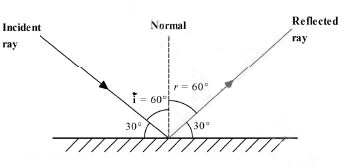
- Figure 2a, 2b and 2c show the process of charging an electroscope by induction.It is observed that the leaf rises in (a), collapses in (b) and then rises in (c).
Explain why the leaf collapses in (b). (3 marks)
Due to earthing. Electrons flow to the earth leading to reduced charges on the leaf and plate. Hence leaf divergence decreases. - State one use of capacitors. (1 mark)
- Used in smoothing circuits (rectification)
- Used in tuning circuits (circuits of radio receivers)
- Used in delay circuits (car indicators)
- Figure 3 shows a graph of magnetic strength against time for two nails P and Q when magnetized in a solenoid. P and Q are of the same size but are made of different materials.
- Identify the material that is magnetized faster. (1 mark)
P - Use the domain theory to explain the answer in 4(a). (2 marks)
P is a soft magnetic material as compared to Q. Hence, less time is taken for the magnetic dipoles to align themselves in the north-south direction until the material reaches its magnetic saturation.
- Identify the material that is magnetized faster. (1 mark)
- State the meaning of the term principal focus of a convex mirror. (1mark)
It is the point at which all rays parallel and close to the principal axis appear to diverge from after reflection by the mirror. - Figure 4 shows a current carrying conductor placed between the poles of two magnets. (The direction of the current is into the paper)
Sketch the magnetic field produced between the conductor and the poles of the magnets. (2 marks)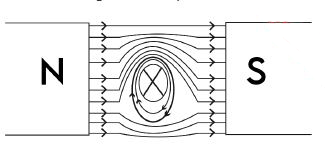
- Figure 5 shows two coherent sources of sound A and B in phase. O is a point equidistant from A and B.
An observer moves from M to N through Q. Explain what is observed at point Q. (3 marks)- As the observer moves from M to Q, he/she will experience alternate loud (constructive interference) and soft (destructive interference) sound.
- At Q, the observer will experience a loud sound (constructive interference) because this is the locus of points equidistant from the two sources, hence the path difference is zero
- State one factor that affects the speed of sound in water. (1 mark)
- Temperature
- Salinity
- Pressure
- Figure 6 shows a ray of light incident on a prism with a critical angle of 42°.
Complete the diagram to show the path of the ray through the prism. (2marks)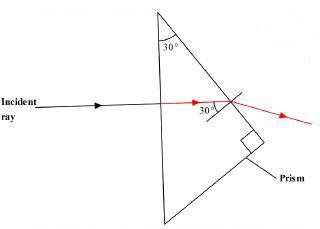
- It is observed that when the heat current of the cathode ray tube is increased, the intensity of the cathode rays increases. Explain this observation. (2 mark)
Increase in heat current increases the energy of electrons to break loose from the force of attraction of the nuclei.
Consequently, more electrons are emitted through thermionic emission increasing the intensity of the cathode rays. - A current of 2A flows through a bulb for 2.5 minutes. Determine the quantity of charge that flows through the bulb. (3 marks)
Q = iT
t = 2.5 x 60
= 150 sec
Q = 2 x 150
= 300 coulombs - Figure 7 shows UV light passing through an aperture and incident on the cathode of a photocell.
- State what is observed on the milliammeter when the size of the aperture is increased. (1 mark)
More deflection / Pointer deflects more / Higher deflection - State the reason for the answer in 12(a). (1 mark)
Increasing the size of the aperture increases the intensity of the UV on the cathode. As a result, more photoelectrons are emitted at the cathode.
- State what is observed on the milliammeter when the size of the aperture is increased. (1 mark)
- State the property of radio waves that makes them suitable for use in communication. (1 mark)
They have longest wavelength in the electromagnetic spectrum.
SECTION B (55 MARKS)
-
- State and explain how increase in temperature affects conductivity of a semi-conductor. (2 marks)
An increase in temperature will reduce the electrical resistance of a semi-conductor. Consequently, this increases chances of an electron moving from the valence band to the conduction band. - Figure 8 shows a graph of potential difference (V) across a bulb against the current (I) through the bulb obtained from an experiment.
Explain why parts:- AO is straight. (1 mark)
Current flowing is directly proportional to the potential difference across the bulb - AB is curved. (2 marks)
Current flowing is not directly proportional to the p.d across the bulb as the bulb is non ohmic.
- AO is straight. (1 mark)
- A circuit consists of 20 identical lamps connected in series to 240 V mains supply. Determine the potential difference across each lamp. (2marks)
Sum of voltage drop across each lamp = supply voltage
20x = 240V
x = 240
20
= 12V
Alternatively;
V = IR
But, I = V/R
=240V
20R
= 12V/R
V = 12V/R x R
= 12V - Figure 9 shows a circuit consisting of two identical lamps and three ammeters A1, A2 and A3 connected to a cell.
Given that Ammeter A1 reads 0.5A:- state the reading on Ammeter A3. (1 mark)
0.25A - explain the answer 14(d)(i). (2 marks)
Since the bulbs are identical, they have similar resistance, hence current is split equally.
- state the reading on Ammeter A3. (1 mark)
- State and explain how increase in temperature affects conductivity of a semi-conductor. (2 marks)
-
- State the use of the eye piece lens in a compound microscope. (1 mark)
- Acts as a magnifying glass.
- Produces a magnified virtual image of the real image formed by the objective lens.
- On the grid provided, draw a ray diagram to show how a convex lens forms a magnified real image. (3 marks)

- Figure 10 shows a defect of vision in a human eye.
- State the type of defect shown. (1 mark)
Long sightedness (Hypermetropia) - State the type of lens that can be used to correct this defect. (1 mark)
Converging lens - On the same figure, draw rays to show how the lens in 15(c)(ii) corrects the defect. (2 marks)
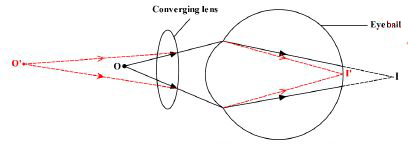
- State the type of defect shown. (1 mark)
- Figure 11 shows a graph of image distance V against the object distance U obtained in an experiment to determine the focal length of a concave mirror.
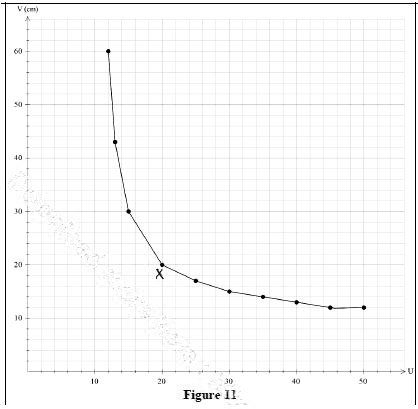
- Identify and mark a point X on the graph where V=U. (1 mark)
- Use point X to determine:
- the radius of curvature r. (2 marks)
Object at C forms an image at I, hence U = V = r
r = 20cm - the focal length of the mirror. (1 mark)
f = r/2
= 20/2 cm
= 10cm
- the radius of curvature r. (2 marks)
- State the use of the eye piece lens in a compound microscope. (1 mark)
-
- State Faraday’s law of magnetic induction. (1 mark)
It states that the magnitude of the induced e.m.f is directly proportional to the rate of change of magnetic flux linkage. - Figure 12 shows a bar magnet being moved towards a solenoid. The solenoid is being connected to a galvanometer.
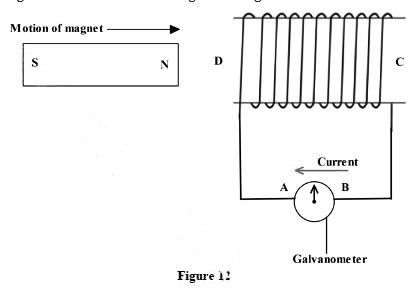
- Indicate on the diagram the direction of the induced current in the solenoid. (1 mark)
- Identify the pole induced at D. (1 mark)
North pole - Explain the answer in 16(b)(ii). (2 marks)
As the north pole of the magnet is moved towards the coil, the induced current flows in the coil, forming an electromagnet with a north pole at the end of the nearest incoming magnet.
This opposes the movement of the magnet. - Apart from the number of turns in the solenoid, state two factors affecting the magnitude of the induced current. (2 marks)
- Rate of change of magnetic flux.
- The angle of deflection between the wire and the magnetic field.
- Explain how laminating the core of a transformer increases its efficiency. (2 marks)
Laminating the core of a transformer reduces eddy currents thus minimizing the heating effect. Hence increases its efficiency.
- State Faraday’s law of magnetic induction. (1 mark)
-
- Explain how a fuse protects electrical devices from damage. (2 mark)
- Fuses are made of short thin wire of low melting point. When current exceeds the fuse rating, the fuse wire gets very hot and melts, hence breaking the circuit.
- Excess current is converted to heat energy which melts the fuse which has a low melting point, hence breaking the circuit.
- State and explain why the voltage in the mains electricity is stepped up before long distance transmission. (3 marks)
To minimize power loss in transmission cables. For any given resistance in a circuit, when the current is high, the power loss is large and when the current is low, power loss is also low, thus stepping up voltage reduces current in a circuit. Therefore, power loss P = I2R is minimized by stepping up voltage. - Figure 13 shows how power can be transmitted from the generating station through transformers P, Q and R to the consumers.
- Identify the type of transformer labelled P. (1 mark)
Step up transformer - Explain how the number of turns in the primary and secondary coils of transformer P affects its output voltage. (3 marks)
Constantly changing current in primary produces a changing magnetic flux per turn which is linked to each turn in the secondary coil (magnetic flux linkage) inducing an e.m.f in each turn. - State the reason why one of the wires from R to the school should be earthed. (1 mark)
To produce a neutral wire which is at zero potential.
- Identify the type of transformer labelled P. (1 mark)
- A power station generates 11kV at a current of 1A. The voltage is stepped up to 160kV before being transmitted through electric cables.
Assuming the transformer is 100% efficient, determine the secondary current. (3 marks)
Vp/Vs = Is/Ip
11kV = Is
160kV 1A
- Explain how a fuse protects electrical devices from damage. (2 mark)
-
- Figure 14 shows a cathode ray tube. A metal plate is placed between the anode and the screen.
- State with a reason what would be observed on the screen when the cathode rays are produced. (2 marks)
A rectangular shadow of the metal plate. Cathode rays travel in a straight line, hence they will be blocked by the metal plate casting a shadow on the screen. - State the effect on the cathode rays produced when the anode potential is increased. (1 mark)
Their quality is increased / Their kinetic energy is increased.
- State with a reason what would be observed on the screen when the cathode rays are produced. (2 marks)
- Explain how X-rays produce photographs of fractures in bones. (2marks)
X-rays penetrate matter but are stopped by the bones which form images on a photographic paper which they affect. - Figure 15 shows monochromatic light incident on the cathode of a photocell connected to points P, Q, R and S through a jockey.
State what will be observed when the jockey is:- connected to point P. (1 mark)
Since there is no external cell, current produced will be minimal, hence milliammeter records slight reading. - connected to point P to Q to R and then to S. (1 mark)
The milliammeter reading will keep increasing.
- connected to point P. (1 mark)
- Explain the answer in (c)(ii). (2 marks)
The cells are connected in a way that they attract the electrons emitted from the cathode of the photocell. So as the jockey is moved to Q, R to S, the milliammeter readings keep increasing. - State how radioactivity may be used to detect oil leakage in and underground pipeline. (2 marks)
The oil is mixed with radioactive element such as Uranium and pumped into the pipeline. A radioactive detector is then moved along the pipeline. In case it detects the radiations emitted, that is the point of leakage.
- Figure 14 shows a cathode ray tube. A metal plate is placed between the anode and the screen.
Download Physics Paper 2 Questions and Answers - KCSE 2021 Past Papers.
Tap Here to Download for 50/-
Get on WhatsApp for 50/-
Why download?
- ✔ To read offline at any time.
- ✔ To Print at your convenience
- ✔ Share Easily with Friends / Students
